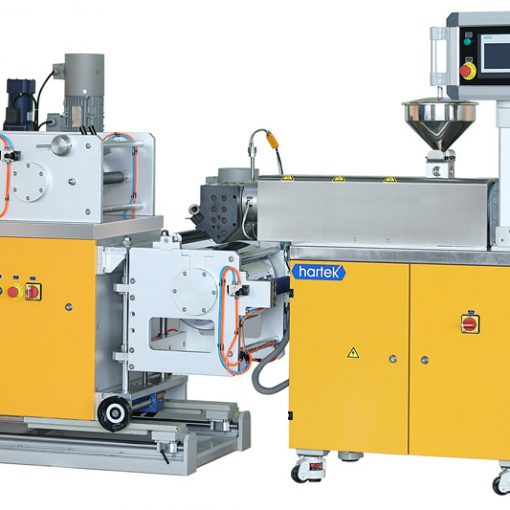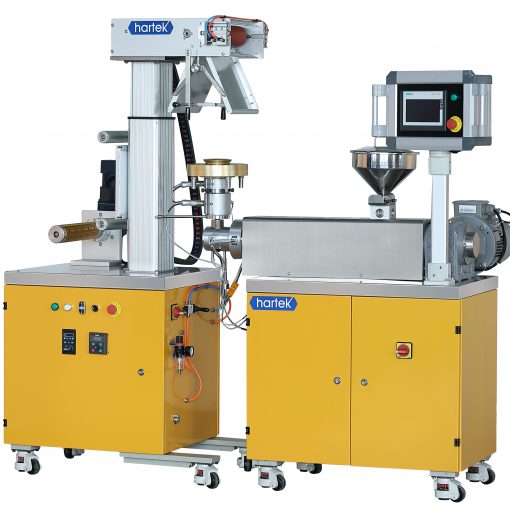To meet the special functional needs of plastic film packaging materials in the production process, various characteristic materials (such as breathability, waterproofing, insulation, toughness, etc.) are blow molded and co-extruded together to form multifunctional plastic films, leading to the development of multi-layer co-extrusion blow molding machines. The purpose of the multi-layer co-extrusion blow molding machine is to utilize the advantages of multiple materials and to avoid some of the drawbacks of single-material or single-layer blow molding machines.

The three-layer co-extrusion blow film experimental line is primarily composed of multiple single-screw extrusion mainframes (2 to 3), a blower device, and a winding device. Unlike traditional extrusion experimental lines, the blow film experimental setup includes not only the traditional mainframe, auxiliary machines, and cooling devices, but also an additional blower device. The blower device is a core component in the blow film experimental line, playing a crucial role in the manufacturing process of plastic films. Its function is to blow air into the die head of the blow molding machine, helping to form the bubble-like structure of the plastic film. In this process, the melted plastic is extruded through the die head and immediately blown into a large bubble by the air from the blower device, eventually cooling into a thin film.
The three-layer co-extrusion blow film experimental line can be divided into two different types of machines at the process level – the ABA type and the ABC type.
ABA Three-layer Co-extrusion Blow Molding Machine: The ABA model consists of two extrusion mainframes, producing a film structure of A-B-A, i.e., two outer layers of the same material and one middle layer. This structure gives the film stronger physical properties, lower cost, and allows the use of a high proportion of recycled materials or calcium carbonate.
ABC Three-layer Co-extrusion Blow Molding Machine: The ABC model consists of three extrusion mainframes. Each extruder can handle different materials, colors, or properties, offering greater production flexibility. It can produce plastic films with three different colors, suitable for more challenging applications such as high-performance packaging films and medical packaging materials.
These two different types of machines can meet many different customized experimental needs.
The emergence of the three-layer co-extrusion blow film experimental line has met various experimental requirements, helping researchers to test and develop new plastic mixtures or additives, explore and optimize production parameters, and it can also be used for small-scale production, performance evaluation, and other projects.
To meet the special functional needs of plastic film packaging materials in the production process, various characteristic materials (such as breathability, waterproofing, insulation, toughness, etc.) are blow molded and co-extruded together to form multifunctional plastic films, leading to the development of multi-layer co-extrusion blow molding machines. The purpose of the multi-layer co-extrusion blow molding machine is to utilize the advantages of multiple materials and to avoid some of the drawbacks of single-material or single-layer blow molding machines.
The three-layer co-extrusion blow film experimental line is primarily composed of multiple single-screw extrusion mainframes (2 to 3), a blower device, and a winding device. Unlike traditional extrusion experimental lines, the blow film experimental setup includes not only the traditional mainframe, auxiliary machines, and cooling devices, but also an additional blower device. The blower device is a core component in the blow film experimental line, playing a crucial role in the manufacturing process of plastic films. Its function is to blow air into the die head of the blow molding machine, helping to form the bubble-like structure of the plastic film. In this process, the melted plastic is extruded through the die head and immediately blown into a large bubble by the air from the blower device, eventually cooling into a thin film.
The three-layer co-extrusion blow film experimental line can be divided into two different types of machines at the process level – the ABA type and the ABC type.
ABA Three-layer Co-extrusion Blow Molding Machine: The ABA model consists of two extrusion mainframes, producing a film structure of A-B-A, i.e., two outer layers of the same material and one middle layer. This structure gives the film stronger physical properties, lower cost, and allows the use of a high proportion of recycled materials or calcium carbonate.
ABC Three-layer Co-extrusion Blow Molding Machine: The ABC model consists of three extrusion mainframes. Each extruder can handle different materials, colors, or properties, offering greater production flexibility. It can produce plastic films with three different colors, suitable for more challenging applications such as high-performance packaging films and medical packaging materials.
These two different types of machines can meet many different customized experimental needs.
The emergence of the three-layer co-extrusion blow film experimental line has met various experimental requirements, helping researchers to test and develop new plastic mixtures or additives, explore and optimize production parameters, and it can also be used for small-scale production, performance evaluation, and other projects.




